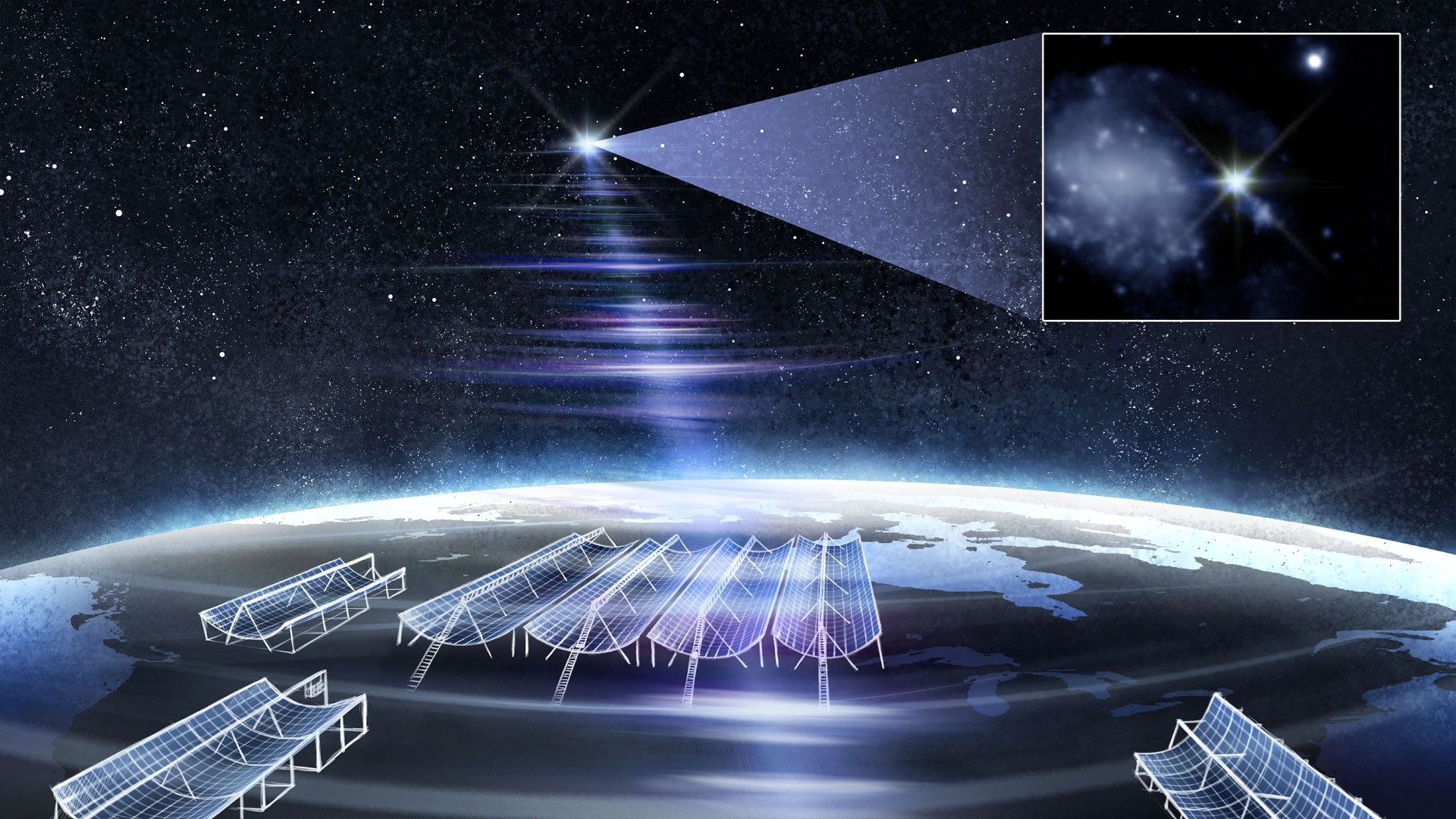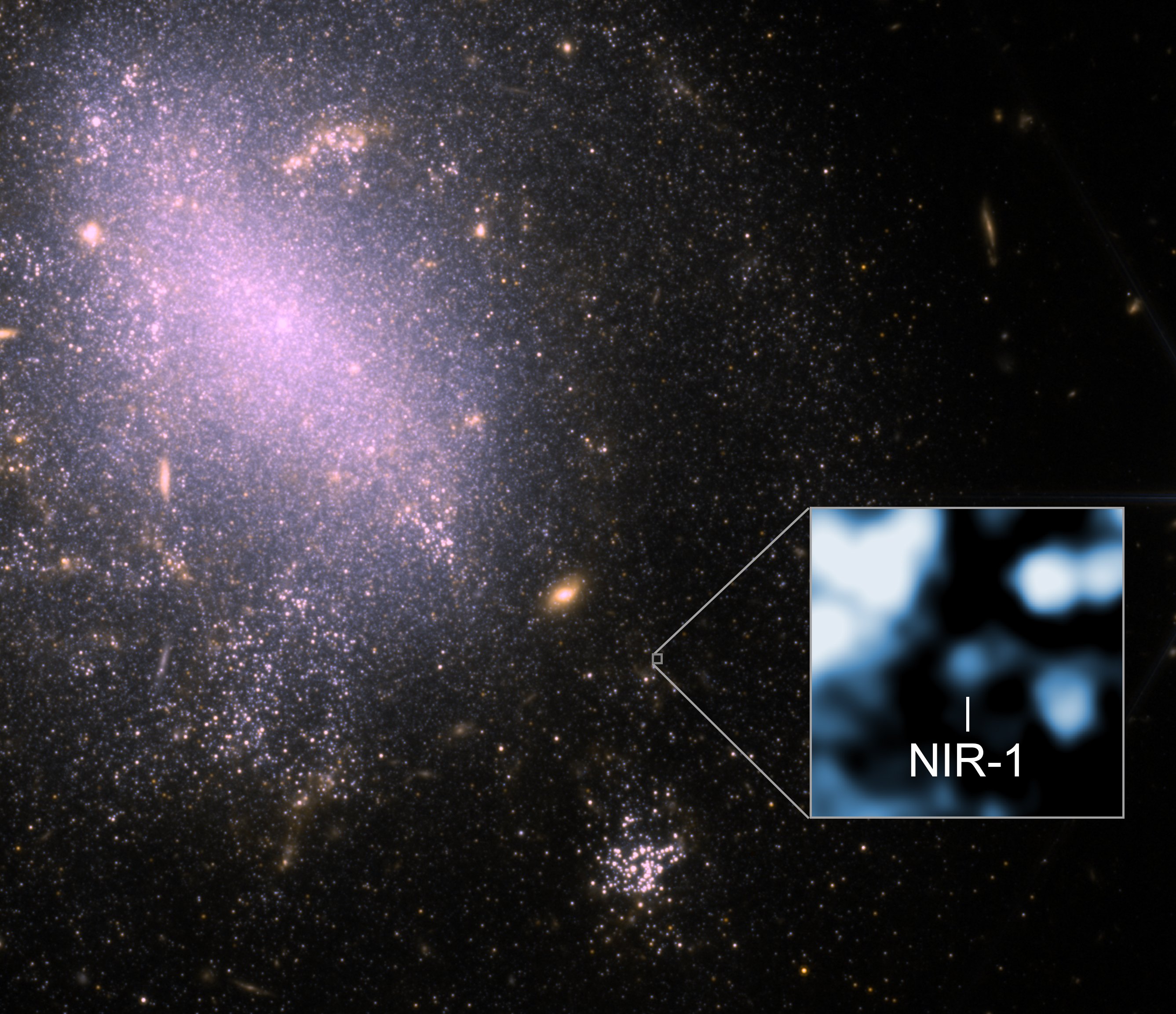A team of international astronomers, including Perimeter Institute researchers, have pinpointed one of the brightest fast radio bursts (FRBs) ever detected to a location in a nearby galaxy. The finding and the location surprised the team and offered new insight into FRBs, which are one of astrophysics’ biggest mysteries.
FRBs are powerful, millisecond-long flashes of radio waves from space. Researchers suspect that they are the result of extreme cosmic events, but have so far been unable to determine the exact origin of any of them. FRBs are notoriously difficult to study because they vanish in the time it takes to blink. For the past several years, the Canadian Hydrogen Intensity Mapping Experiment (CHIME) has been casting a broad net to catch these rare astrophysical events. Now it can also pinpoint their origin.
A particularly bright FRB was detected in March from the direction of the Big Dipper by the Canadian CHIME/FRB radio-telescope. Referred to as FRB 20250316A, affectionately dubbed “RBFLOAT” for Radio Brightest FLash Of All Time, this FRB marks a significant change for researchers because it allowed for the identification of a point of origin using only CHIME/FRB, the most prolific FRB discovery machine.
“This result marks a turning point: instead of just detecting these mysterious flashes, we can now see exactly where they’re coming from. It opens the door to discovering whether they’re caused by dying stars, exotic magnetic objects, or something we haven’t thought of yet,” said Amanda Cook, a McGill-based Postdoctoral Researcher and lead of the study announcing the discovery.
‘Like spotting a quarter from 100km away’
To investigate RBFLOAT’s origin, the researchers relied on CHIME’s newly completed “outrigger” telescopes, which span North America from British Columbia to California. This array of vantage points gave them unprecedented spatial resolution, allowing them to trace the burst to a region just 45 light years across – smaller than the average star cluster – in the outskirts of a galaxy about 130 million light-years away.
"It's a really nice demonstration of CHIME's new capabilities that are coming online. The outrigger stations give CHIME much greater precision when tracing the origins of FRBs, helping us better understand the stellar conditions that set off these radio bursts," said Kendrick Smith, Daniel Family James Peebles Chair in Theoretical Physics at Perimeter Institute, and member of the CHIME/FRB collaboration.
“The precision of this localization, tens of milliarcseconds, is like spotting a quarter from 100 kilometres away,” said Cook. “That level of detail is what let us identify the host galaxy, NGC 4141, and match the burst with a faint infrared signal captured by the James Webb Space Telescope (JWST).”
That, in turn, revealed a mysterious source of near-infrared light in the exact spot where RBFLOAT occurred. This surprised the researchers, who theorize that the spot might be something like a red giant star or a fading light echo from the burst itself.
“The high resolution of JWST allows us to resolve individual stars around an FRB for the first time. This opens the door to identifying the kinds of stellar environments that could give rise to such powerful bursts, especially when rare FRBs are captured with this level of detail.” said Peter Blanchard, a Harvard Research Associate and lead author of a companion paper released at the same time.
Despite being the brightest yet seen by CHIME, researchers have not detected repeat bursts from the source, even in the hundreds of hours its position was observed by the CHIME survey instrument over more than six years. That goes against the prevailing idea that all FRBs eventually repeat.
“It seems different energetically than the repeaters we’ve studied. We’re now re-examining some of the more explosive models that had fallen out of favour,” said Mawson Sammons, a postdoctoral researcher at McGill. Sammons works with Victoria Kaspi, astrophysicist and professor at McGill, who co-leads the CHIME/FRB research team of roughly 100 scientists.
New possibilities
The new observations are described through two studies: one is focused on the original radio discovery and localization of the burst, and the other on JWSTs near-infrared images of the location from which the radio burst originated. Together, they provide detail and new possibilities for studying FRBs, not just as cosmic curiosities but as tools to probe the universe.
“This marks the beginning of a new era where we can routinely localize even single, non-repeating bursts to pinpoint precision. That’s a game-changer for understanding what’s behind them,” said Sammons.
About the studies
“FRB 20250316A: A Brilliant and Nearby One-Off Fast Radio Burst Localized to 13 parsec Precision” by the CHIME/FRB Collaboration which includes astrophysicists from Perimeter Institute, McGill University, the Massachusetts Institute of Technology, the University of Toronto, Northwestern University, the University of British Columbia, West Virginia University, and many other institutions, was published in The Astrophysical Journal Letters.
“James Webb Space Telescope Observations of the Nearby and Precisely-Localized FRB 20250316A” led by Peter Blanchard and Edo Berger of the Center for Astrophysics | Harvard & Smithsonian, and members of the CHIME/FRB Collaboration, was published in The Astrophysical Journal Letters.
The work was supported by the Trottier Space Institute at McGill University, the Gordon and Betty Moore Foundation, the Canada Foundation for Innovation and the Natural Sciences and Engineering Research Council of Canada, among other international partners.
About PI
Perimeter Institute is the world’s largest research hub devoted to theoretical physics. The independent Institute was founded in 1999 to foster breakthroughs in the fundamental understanding of our universe, from the smallest particles to the entire cosmos. Research at Perimeter is motivated by the understanding that fundamental science advances human knowledge and catalyzes innovation, and that today’s theoretical physics is tomorrow’s technology. Located in the Region of Waterloo, the not-for-profit Institute is a unique public-private endeavour, including the Governments of Ontario and Canada, that enables cutting-edge research, trains the next generation of scientific pioneers, and shares the power of physics through award-winning educational outreach and public engagement.


